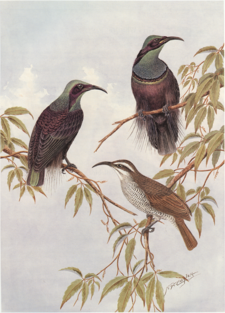- Magnificent Riflebird
-
Magnificent Riflebird 
Neville William Cayley's illustration of the immature male, mature male, and female Magnificent Riflebird. Conservation status Scientific classification Kingdom: Animalia Phylum: Chordata Class: Aves Order: Passeriformes Family: Paradisaeidae Genus: Ptiloris Species: P. magnificus Binomial name Ptiloris magnificus
Vieillot, 1819The Magnificent Riflebird, Ptiloris magnificus, is a medium-sized (up to 34 cm long) passerine bird of the Paradisaeidae family. The male is velvet-black bird of paradise with elongated black filamental flank plumes, an iridescent blue-green crown, a wide, triangle-shaped breast shield, and on central tail feathers. It has a black curved bill, yellow mouth, blackish feet and a dark brown iris. The female is brownish with dark spots and buff bars below.
The Magnificent Riflebird is widely distributed throughout lowland rainforests of New Guinea and far Northeastern Australia. The diet consists mainly of fruits and arthropods.
Males are polygamous and perform solitary courtship displays on a 'dancing perch'. During these displays, the male fully extends his wings and raises his tail; he hops upward while swinging his head from side to side, showing off his metallic blue-green breast shield. Multiple females will observe these displays, and, if satisfied with the performance, reward the male with copulations. Females subsequently build nests, incubate, brood, and feed young without male assistance.
A widespread and relatively common species throughout its range, the Magnificent Riflebird is evaluated as a species of Least Concern on the IUCN Red List of Threatened Species. It is listed on Appendix II of CITES.
This species used to be placed in its own genus, Craspedophora Gray, 1840, which is now a subgenus of Ptiloris.
References
- BirdLife International (2004). Ptiloris magnificus. 2006. IUCN Red List of Threatened Species. IUCN 2006. www.iucnredlist.org. Retrieved on 29 October 2006. Database entry includes justification for why this species is of least concern
External links
Birds-of-paradise (family: Paradisaeidae) Genera and species LycocoraxParadise-crowArfak Astrapia • Splendid Astrapia • Ribbon-tailed Astrapia • Princess Stephanie's Astrapia • Huon AstrapiaWestern Parotia • Queen Carola's Parotia • Bronze Parotia • Lawes's Parotia • Eastern Parotia • Wahnes's ParotiaPteridophoraKing of Saxony Bird-of-paradiseLophorinaSuperb Bird-of-paradiseMagnificent Riflebird • Growling Riflebird • Paradise Riflebird • Victoria's RiflebirdSemiopteraStandardwingSeleucidisTwelve-wired Bird-of-paradiseLesser Bird-of-paradise • Greater Bird-of-paradise • Raggiana Bird-of-paradise • Goldie's Bird-of-paradise • Red Bird-of-paradise • Emperor Bird-of-paradise • Blue Bird-of-paradiseIncomplete list of likely hybrids Astrapian Sicklebill • Barnes' Astrapia • Bensbach's Bird of Paradise • Blood's Bird of Paradise • Duivenbode's Bird of Paradise • Duivenbode's Riflebird • Duivenbode's Six-wired Bird of Paradise • Elliot's Bird of Paradise • False-lobed Astrapia • Gilliard's Bird of Paradise • King of Holland's Bird of Paradise • Lupton's Bird of Paradise • Lyre-tailed King Bird of Paradise • Mantou's Riflebird • Maria's Bird of Paradise • Mysterious Bird of Bobairo • Rothschild's Bird of Paradise • Rothschild's Lobe-billed Bird of Paradise • Ruys' Bird of Paradise • Schodde's Bird of Paradise • Sharpe's Lobe-billed Parotia • Stresemann's Bird of Paradise • Wilhelmina's Bird of Paradise • Wonderful Bird of ParadiseThis Paradisaeidae-related article is a stub. You can help Wikipedia by expanding it.

